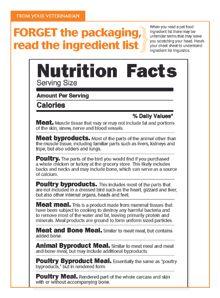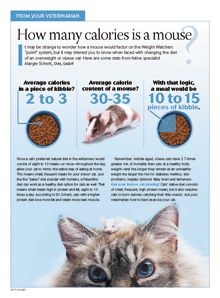Veterinary nutrition: Easy as 1, 2, 3
Cut through the marketing hype and help your clients find the right food for their pets with this veterinary nutritionists expert tips.

Getty ImagesVeterinary nutrition consultant Lisa Weeth, DVM, DACVN, says when she went through veterinary school, when it came to nutrition, veterinarians were supposed to tell clients to pick a good-quality company and feed it. “We were told, ‘Don't question; just do it,'” Weeth recalls. “But today's pet owners don't view the relationship as a paternal one. They want input.”
Weeth says veterinarians can walk pet owners through the process of choosing the right food for their pet in three steps that cut through manufacturers' marketing claims and meet the needs of pets and owners.
1. Start with the animal
Weeth says the first step is to identify the nutritional needs of the animal. This may be a simple task if you're dealing with a generally healthy dog or cat, but something more involved may be necessary for a pet with medical considerations such as an allergy or renal condition. From there she comes up with an appropriate ingredient list.

Dr. Lisa Weeth, DACVNShe says while there's no hard and fast rule to what pet owners should look for in pet food, she does believe the first five ingredients should be recognized as foods. “You want to look for ingredients that you recognize,” Weeth says.
2. Identify trustworthy manufacturers
Once you and the pet owner are happy with the ingredient list, Weeth says, the next step is to make sure the manufacturer is trustworthy. “Every label will have a statement on it: ‘Manufactured by X brand' or ‘Manufactured for X brand,' she says. “When you look at that, if it's ‘for,' the company is just the marketing arm.” In this case, she says, the company may not monitor the quality of the product: “They just make a great label and make money.”
While it's easy for pet owners to get caught up in the vast array of ingredients and claims on pet food labels, Weeth says quality often comes down simply to who's making the food. “I worry less about ingredients. I look at who manufactures the diet,” she says.
Strict manufacturer guidelines may be essential in situations where allergies are a factor. It may be vitally important that the brand manufacturer creates individual batches to avoid cross-contamination between productions of different diets.
In general, Weeth says to look for manufacturers that use higher-quality ingredients, that conduct preproduction testing, that test for food safety on the lines and with the end product, and who are responsive to questions. “When you have a brand you're happy with, then you look at which one of their foods is going to match with the animal,” she says.
3. Choose a formula that suits the pet-and client
As a pet's veterinarian, you know what food is adequate for its complete nutrition. For some owners, choosing a food that meets the nutritional requirements you've set from manufacturers you trust is a welcome answer to “What should I feed my pet?” However, many pet owners want a product that doesn't just meet nutritional requirements but aligns with their own priorities. That may mean food that is “human grade,” “all natural,” contains no byproducts or is simply affordable.
Often, pet owners can find what they're looking for within the multiple formulas one trusted brand provides. Weeth concedes sometimes that takes educating the client about certain pet food claims and nutrition trends.
> Byproducts. “The reason byproducts have a bad reputation is because the companies that don't include byproducts are marketing,” Weeth says. “Consumers automatically think there must be something wrong. Really, it's a marketing ploy.”
Client education resources: Veterinary nutrition handouts
Check out these handouts and more at dvm360.com/nutritionhandouts.

The pet food guessing game. Once you get past the marketing and product claims, what are veterinary clients really feeding pets?

3 pet food myths.With so many pet food options, choosing the right diet can be tricky. Help clients with this handout.

Forget the packaging, read the ingredient list. Provide veterinary clients with a pet food ingredient cheat sheet to better understand what's in their pets' food.

How many calories is a mouse? It may be strange to wonder how a mouse would factor on the Weight Watchers “point” system, but it may provide an interesting perspective to veterinary clients faced with changing an overweight cat's diet.
Weeth explains byproducts to clients by saying they're byproduct of the human food chain. “It's a more environmentally conscious and sustainable source of protein for pet food,” she says. These are the parts of the animals the American human food market isn't using-a way to use the leftovers. “I don't worry about byproducts. For the generally healthy dog, byproducts are a great source of protein and nutrients,” she says. “The only time I worry about byproducts is with an animal with liver disease who shouldn't be consuming organ meats.”
Further, she says pet owners might need help clarifying terms such as “meat” and “poultry.” “It's not horse; it's not roadkill; it's one of four animals,” Weeth says. The U.S. Food and Drug Administration as well as the Association of American Feed Control Officials say the generic term “meat” is sourced from cattle, pigs, sheep or goats.
“The only time I worry about that is with a dog with food allergies,” Weeth says. That's because a diet that includes “meat” can be altered-nine out of 10 batches might contain an animal protein other than beef. And a dog that's allergic to beef might do great with the food until it gets that 10th batch.
> Human grade, non-GMO or organic. These nutrition trends are rampant in the human food market and have captured the creativity of the pet-food-marketing machine. Weeth says sometimes you have to dispel the myths surrounding these terms. “The reality is nothing that goes into pet food is human grade,” she says. Once a food leaves a USDA inspected facility, it's pet food.
Non-GMO, or non-genetically modified organisms, is also a misleading term, Weeth says. “Even if you're not feeding GMO corn [to your pet], those foods are being fed to the food animals. Why would you avoid GMO food if you're feeding chicken that were fed GMO corn?” she asks.
When it comes to organic, there is a general expectation that the food is produced according to USDA regulations. However, Weeth says, monitoring and testing whether a pet food truly is organic is a low priority for USDA, as there are no official rules governing the labeling of organic foods for pets.
That's sometimes a necessary point to make with pet owners. Especially those who, with best intentions, come in after doing extensive research, most likely online, to try to find what they think is the best food for their pet. It usually means they've found a boutique brand. “I go back to the manufacturer,” Weeth says. “Let's look at who makes it. If it's a third-party manufacturer who doesn't maintain quality control, you really don't know what's in the bag. It's a lot of marketing from smaller companies who are trying to get a piece of the $30 billion pie,” Weeth says.
> Low-cost. Weeth believes that many lower-cost foods can be higher quality than more expensive foods. She says less expensive food often have more flexibility. For example, manufacturers that only source pork liver, she says, builds cushion into their pricing to allow for market fluctuations. Whereas a manufacturer that just lists “liver” can switch from one animal protein source to another.
But Weeth says consumers should read the label on lower-cost pet foods to see how many animal proteins versus plant proteins are used. She says it's important that cat food contain an animal protein in those first five ingredients, because cats have a higher protein requirement than dogs. She says protein should make up 30 to 40 percent of dry cat food-ideally animal protein-whereas dogs require 20 to 30 percent.
Weeth says if veterinarians initiate and participate in the nutrition conversation, get over being perceived as “selling” when it comes to pet food and get past the fact they too are overwhelmed by the countless brands and varieties of pet food on today's market, clients will get the information they need to make the best nutritional choices for pets.